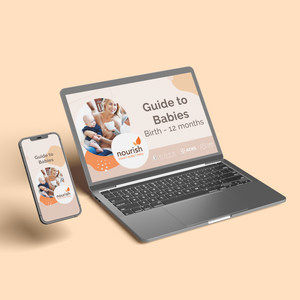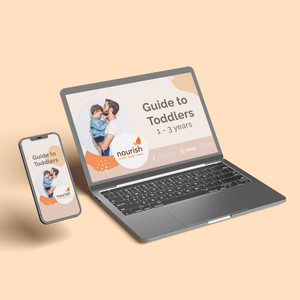There are loads of wonderful benefits to being skin-to-skin with your newborn immediately after birth and in the weeks following, not the least of which is establishing breastfeeding.
Given the opportunity, most babies if placed on mum’s chest – skin-to-skin, will shuffle up to the breast, latch on and start breastfeeding all by themselves!
Baby led attachment allows your baby to follow her natural instincts to get to your breast. This process may take up to an hour or longer, but you and your baby should be given this time together to start learning about each other. Research has shown that babies who "self-attach" experience far fewer breastfeeding problems.
If you baby is born in a baby friendly hospital as part of the baby friendly hospital initiative, they allow your baby to be on your chest skin-to-skin for the first hour which is really important for establishing breastfeeding. Being skin-to-skin triggers the inborn feeding response.
What If I have a Caesarean Section?
Even if you have a planned (or unplanned) caesarean section you can still request skin-to-skin time either in the operating theatre or in recovery. If you can however, speak to your hospital about this ahead of time. Having a c-section shouldn’t deter you from having skin-to-skin time and the first feed with your baby within the first hour.
A newborn baby retains the reflex to self attach to the breast for about 6 weeks after birth. If you’re having attachment issues, giving your baby the opportunity to go back to the “basics” and self-attach, may help you overcome these difficulties.
How to Encourage Baby Led Attachment
Wear an open top so nothing gets in the way of baby finding their way to your breast. Similarly, undress baby down to her nappy so her clothing does not restrict her movement.
Your skin and body regulates temperature so don’t worry about baby getting cold.
Support your baby’s body and place her on your chest - you may find leaning back works well.
Give your baby time to make her way to your breast – allow her to move freely and resist the urge to give her too much direction.
Baby is driven by the smell of your milk. She can also recognise the darkness of the areola (the ring of pigmented skin surrounding your nipple).
Once she finds your breast you may like to scoop her bottom close to you and move her body across yours into a cradle position, so you can support her back and shoulders with your arm as she latches on. Keeping her bottom in close will help ensure she gets a good latch.
To check that your baby is attached well, look for these signs:
- Chin is pressed into the breast and nose is clear.
- Mouth is open wide and lips are flanged (protruding out on to the breast).
- Baby has a ‘good mouthful’ of the areola in her mouth.
- There is no pain.
- She is not sucking in air or slipping off the breast.
- Her cheeks are not hollow as she sucks.
Babies (and mothers!) find self-attaching quite relaxing as it lets their instincts take over.
Baby led attachment also promotes bonding as it facilitates the release of oxytocin (the feel-good “love” hormone!).
Our Products
-

01. Guide to a Healthy Pregnancy
$55 -

02. Positive Birthing Course
$55 -

03. Infant Feeding Guide
$55 -

04. Baby Sleep Guide - First 12 Months
$55 -

05. Toddler Parenting Course 1 - 3 Years
$55
-
 When to Start Antenatal Classes?
When to Start Antenatal Classes?
Becoming a parent is an incredible milestone, but it comes with a host of changes that can be daunting, especially for first time parents. Antenatal classes are all about offering expectant parents the education they need to make informed decisions, look after their bodies and care for their newborn babies. While you probably already have a long list of things you need to accomplish during your pregnancy, it’s a good idea to make time to attend antenatal classes.
-
 Development Milestones 4-8 Months
Development Milestones 4-8 Months
As they reach the middle of their first year, you'll start to see bigger leaps in their growth and ability!
In this article, we’re going to discuss your baby’s developmental milestones between 4-8 months, and what you can expect along the way.





 When to Start Antenatal Classes?
When to Start Antenatal Classes?
 Development Milestones 4-8 Months
Development Milestones 4-8 Months








